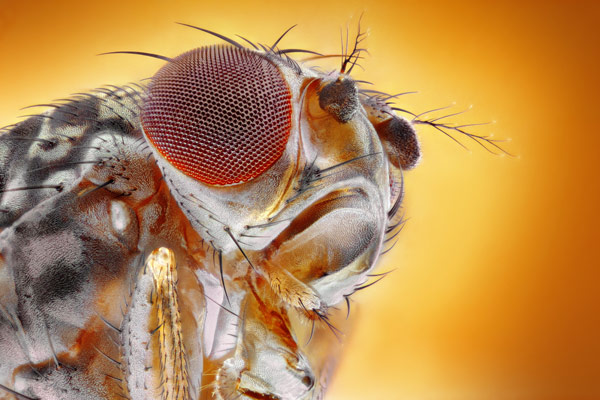THIS ARTICLE IS MORE THAN FIVE YEARS OLD
This article is more than five years old. Autism research — and science in general — is constantly evolving, so older articles may contain information or theories that have been reevaluated since their original publication date.

Tomatito/Shutterstock.com Genetic fitness: Hundreds of genetic variants modulate fly traits that influence their survival in the wild.
Researchers have generated and sequenced almost 200 different strains of fruit flies, a widely used model organism, according to a study published 8 February in Nature1. The resource they created, called the Drosophila Genetic Reference Panel, will enable researchers to link genetic variants with aspects of fly biology and behavior.
Genes, and variations to them — called a genotype — drive the biological characteristics, or phenotype, of an organism. But the idea that one gene contributes to one phenotype has long been disproven. Instead, a number of different genes and genetic variants combine to modulate various aspects of multiple phenotypes. For example, eye color was once thought to be determined by one dominant gene, but as many as 16 genes play a role in it.
In the new study, researchers took advantage of the relatively small fruit fly genome — which is about 10 times smaller than that of people — to show just how complex the relationship between phenotype and genotype really is.
Researchers generated 192 inbred lines of fruit flies, in which both copies of each of their genes are the same. However, each of the 192 fly strains has a different subset of genetic variants, providing a large amount of genetic diversity across the group.
They then sequenced 168 of these lines and mapped more than 4.6 million single nucleotide polymorphisms (SNPs), or alterations to single DNA base pairs; as well as insertions and deletions of base pairs; large duplications and deletions, called copy number variants; and regions of the genome that are prone to rearrangement during cell division. The latter are known as microsatellites.
The researchers then looked for associations between these variants and three fly traits that could have an impact on their survival in the wild: how long they can live without food, how long it takes them to recover from a coma-like state that is induced by cold exposure and how long they fly around after their enclosure is jostled.
Settling down quickly after sudden movement of their enclosure is associated with 90 SNPs, recovering faster from a freeze coma is associated with 235 SNPs, and 203 SNPs are linked to resistance to starvation, the study found. The researchers also identified a number of microsatellites associated with each trait.
The hundreds of novel candidate genes this study links with fly behavior highlight the complex relationship between genotype and phenotype, the researchers say.
Data on SNPs associated with the 168 fly lines studied in the paper are available for download on the Drosophila GeneticReference Panel website.
Future studies using these strains will help clarify the relationship between genotype and phenotype by mapping specific fly characteristics to specific patterns of genomic variation. This could extend to studies of disease. Flies have versions of about 73 percent of human disease-causing genes and have been used to inform research on complex genetic disorders, such as autism.
Results from fruit fly studies will also inform genome-wide association studies that link SNPs to disorders, such as autism, in people, but that need to be very large to generate statistically significant results.
References:
1: Mackay T.F. et al. Nature 482, 173-178 (2012) PubMed
By joining the discussion, you agree to our privacy policy.